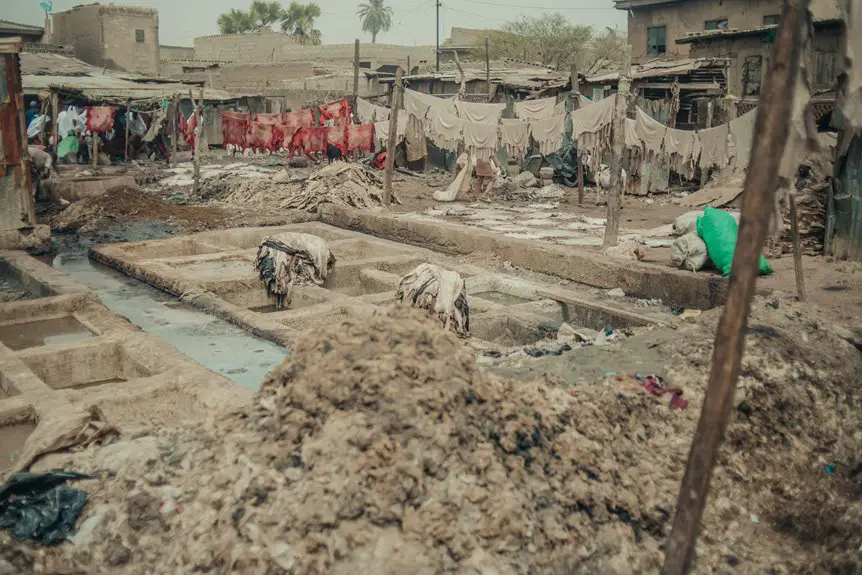To stop fabric bleeding and set dye permanently, start by separating your laundry by color and turning garments inside out. Pre-soak new clothes in a vinegar solution, and use color-catcher sheets in the wash. Opt for cold water and gentle detergents to minimize bleeding. After washing, air dry your clothes and consider using a vinegar rinse to further lock in colors. Want to discover more tips on maintaining vibrant fabrics? Keep exploring for proven methods!
Key Takeaways
- Soak new garments in a vinegar and water solution for 30 minutes to help set the dye before washing.
- Add half a cup of salt to the wash cycle to enhance dye retention and minimize bleeding.
- Use cold water for washing to prevent colors from running and maintain fabric integrity.
- Turn garments inside out to protect the fabric surface and reduce friction during washing.
- Incorporate color-catcher sheets into the wash to trap loose dyes and prevent transfer between fabrics.
Understanding the Causes of Fabric Bleeding
When you wash fabrics, you might notice colors running or bleeding, which can ruin your clothes. This often happens due to the dye used in the fabric. Some dyes aren’t set properly, meaning they can release color when exposed to water.
Additionally, heat can exacerbate this issue, causing the dye to loosen even more. Fabrics made from natural fibers, like cotton or wool, are especially prone to bleeding, as they absorb water more readily than synthetic materials.
If you mix dark and light colors, the risk increases, as darker dyes can transfer to lighter fabrics. Understanding these causes can help you make better choices when washing, minimizing the likelihood of color mishaps in your laundry.
Effective Prevention Techniques Before Washing
To prevent fabric bleeding, it’s important to take a few proactive steps before washing your clothes.
First, always check care labels for specific washing instructions.
Separate your laundry by color—keep darks, lights, and whites apart to minimize the risk of dye transfer.
Additionally, turn your garments inside out; this protects the fabric’s surface during washing.
If you’re washing new clothes, consider pre-soaking them in cold water for about 30 minutes to help set the dye.
You can also use a color-catcher sheet in the wash, as it traps loose dyes.
Finally, wash in cold water whenever possible; it helps preserve colors and reduces bleeding.
Home Remedies and Additives to Set Dye
While you can take preventive measures before washing, using home remedies and additives to set dye can further enhance color retention in your fabrics.
One effective method is to soak your new garments in a solution of white vinegar and water before the first wash. This naturally helps to set the dye.
Soaking new garments in a vinegar and water solution before the first wash helps naturally set the dye.
Another option is to use salt; adding half a cup of salt to your wash can also aid in dye retention.
Baking soda is another handy ingredient; it can help brighten colors while ensuring they don’t bleed.
Finally, consider using commercial dye fixatives available in stores, as they’re specifically designed for this purpose.
Using these remedies can maintain vibrant colors and keep your fabrics looking fresh longer.
Washing Techniques to Minimize Bleeding
How can you wash your fabrics to prevent color bleeding? Start by separating your laundry into darks, lights, and whites. This prevents dyes from darker fabrics transferring to lighter ones.
Use cold water instead of hot; it helps keep colors from running. When choosing a detergent, pick one formulated for colors or a gentle, pH-neutral option to protect the dye.
Always wash your fabrics inside out to minimize friction and fading. You might want to use a gentle cycle, as it’s less harsh on the fibers.
If you’re worried about bleeding, add a color catcher sheet to the wash. Finally, avoid overloading your washing machine to guarantee proper water circulation, which also helps reduce bleeding.
Post-Wash Strategies to Maintain Color
Once you’ve washed your fabrics, taking a few simple steps can help maintain their vibrant colors.
First, always air dry your clothes rather than using a dryer; high heat can fade colors quickly. If you must use a dryer, opt for the lowest heat setting.
Next, store your fabrics away from direct sunlight, as UV rays can bleach colors over time.
Consider using color-safe detergents for future washes, as they’re gentler on dyes.
Additionally, you can add a cup of white vinegar to your rinse cycle; it helps set colors and reduce fading.
Finally, avoid overloading your washing machine; it allows fabrics to move freely, preventing friction that can lead to color loss.
Frequently Asked Questions
Can I Use Fabric Softener With Color-Safe Detergents?
Yes, you can use fabric softener with color-safe detergents. Just make sure to follow the instructions on both products. They’re designed to work together, helping you maintain your fabrics’ softness and vibrant colors.
How Often Should I Repeat Vinegar or Salt Treatments?
You might think occasional treatments are enough, but repeating vinegar or salt treatments every few washes guarantees the colors stay vibrant. Consistency’s key to maintaining fabric quality and preventing unwanted bleeding over time.
What Types of Fabrics Are Most Prone to Bleeding?
Certain fabrics, like cotton, rayon, and silk, are more prone to bleeding due to their dyeing processes. You’ll want to handle them carefully, especially when washing or drying, to avoid unwanted color transfer.
Is It Safe to Dry Clean Bleeding Fabrics?
Yes, it’s generally safe to dry clean bleeding fabrics, but always check the care label first. Dry cleaning often helps preserve colors, though you might want to mention the bleeding issue to the cleaner for best results.
Can I Fix Already Bled Colors on My Garments?
You can try to fix bled colors by using color remover or a dye fixative. Alternatively, re-dyeing the garment in a similar shade might help. Always test on a small area first to avoid further damage.

